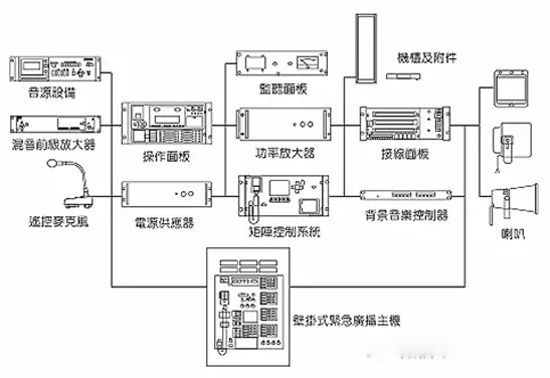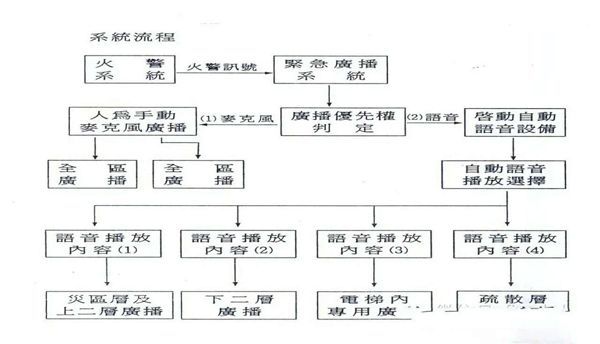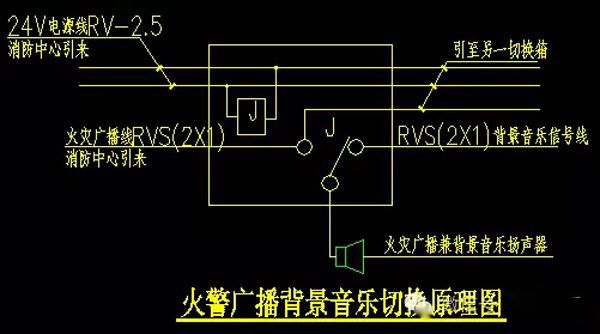At present, it is common to design and install background music systems in newly built or renovated buildings or public entertainment venues. As an emergency alarm broadcasting system in case of fire, it is necessary to consider installation according to the "Design Specification for Automatic Fire Alarm Systems". These two systems have similar functions. In order to save costs and maximize the use of devices with the same functions, more and more designs are integrating these two systems to make them compatible for implementation. However, the prerequisite for compatibility of this device is to ensure that the two systems can switch signals in case of emergency, so that emergency alarm broadcasting is in an absolute priority state.
Architecture diagram of emergency broadcasting system

Emergency broadcast operation flowchart



Emergency broadcast operation flowchart

Emergency broadcast words
First broadcast (warning, broadcast three times)
Attention all personnel: There is a fire in the XXX area now. Please do not panic. We will take emergency measures such as cutting off the power supply! If further action is taken, we will broadcast a notification to everyone!
Second broadcast (emergency evacuation, multiple broadcasts)
Attention all personnel: Emergency evacuation is now in effect! Please don't panic! Follow the instructions of the on-site staff! Please follow the on-site evacuees to evacuate towards the safe passage!
Self inspection checklist
The self inspection form for engineering construction is the most basic quality verification form, which is used by contractors to check whether their construction quality meets the requirements of the owner during the construction process. In order to ensure and implement the quality of engineering construction, it must be reviewed and compiled in accordance with the contents of the contract, specifications, regulations, rules, industrial standards, construction instructions, construction drawings, procedures, and quality management forms. During the inspection, the on-site engineer should fill in the inspection form in detail in order of whether the inspection results are qualified or unqualified and sign it.
The content of the self inspection checklist should at least include: project name, inspection date, inspection location, form number, inspection items, inspection standards, inspection values, qualified or unqualified inspection results, and signature fields of the on-site engineer and site director.
The format, writing, and usage of the self inspection checklist are briefly described as follows:
(1) Format and Writing Method of Self Inspection Checklist
Project name: According to the name contracted by the owner
Inspection date: Fill in the inspection date
Inspection location: Depending on the location, room, or floor where the equipment is installed
Form number: The number of the self inspection checklist form
Inspection content: Arrange the items, design specifications, manufacturer's manuals, operating procedures, or quality management tables according to the contractual requirements related to the installation equipment, and arrange them in sequence according to the operational functional links. If measuring instruments are required for inspection, the number of the measuring instrument used should be added to the inspection item column.
Inspection standards: Based on the requirements documents or specified values specified in design specifications, construction specifications, regulations, rules, industrial standards, manufacturer's manuals, operating procedures, etc.
Inspection value: Used by inspectors to fill in the inspection value as a reference for determining whether it is qualified or unqualified.
Inspection results: for inspectors to fill in the situation of qualified or unqualified; If there are any non-conforming items, the non-conforming handling procedures should be followed until the non-conforming issues are resolved.
On site engineer, project manager, and other fields are provided for relevant personnel to sign.
(2) Usage of Self Inspection Checklist
List items: Check and honestly record each item. If there is no such item, it should be noted as not applicable.
When the on-site engineer and construction site director sign, indicate the inspection date and time.
Keep inspection records for inspection or evaluation analysis purposes.
In daily maintenance, it is recommended that homeowners, property management units, and fire maintenance companies use software similar to iFire Fire Protection to enhance their service awareness and sense of responsibility in fire maintenance. The software integrates standardized maintenance and repair procedures with NFC technology, intelligently distributes maintenance tasks according to maintenance contracts, and provides automatic generation of multi project maintenance plans to solve the dilemma of service omissions and delays. By utilizing information technology to locate personnel in four dimensions, we ensure the objectivity and accuracy of various inspection record forms, achieve paperless and data visualization of facility and equipment management, effectively reduce the company's operating costs, and improve the quality of maintenance.
Switching between background music and emergency broadcast
Several situations that require switching
In practical use, some newly built buildings are basically multi-purpose, with shopping malls, entertainment, offices, and guest rooms. On the one hand, they have their own offices, and on the other hand, some are rented out. This allows the background music system of the entire building to have many other signals inserted and played in different areas during the playback process, including:
⑴ While playing background music normally, it should have the function of temporarily broadcasting to find people and inserting promotional advertisements. It takes the form of interrupting or overlaying the background music in a broadcast.
⑵ Insertion of unmanned work schedule. Insert daily routines (such as chimes, music, or other sound effects) into relevant locations in a predetermined chronological order.
The insertion of this signal is the signal "insertion" in the background music system, and the "switching" discussed in this article refers to the switching between background music and emergency alarm broadcast in case of emergency. In this switching, emergency alarm broadcast is absolutely prioritized, that is, when the system receives an emergency fire signal, regardless of the background music situation, the system will switch to the emergency alarm broadcast state, thus completing the task of "switching".
The 'switch' includes the following methods.
① Fully cut
When an emergency situation occurs in any area of the building, according to the requirements of the "design specifications", the system should implement emergency alarm broadcasting to the accident floor and adjacent floors. At this time, other floors do not broadcast emergency alarms, but stop playing normal background music and remain in a mute state. This "switching" method is called "full switching", which involves simultaneously switching the low-level signal of the background music and emergency alarm broadcast signal source with the signal in front of the corresponding alarm floor amplifier. There are two sets of signal sources in this device, and other intermediate devices such as power amplifiers and speakers are "compatible", but the signal input terminal of the power amplifier needs to have a priority port input.
② Switching of relevant floors
The difference between this method and the "full cut" method is that in case of emergency, the emergency alarm broadcast only switches to the accident floor and adjacent floors, while other floors play background music as usual without special requirements for broadcasting. In this method, there are basically two sets of equipment (including signal source, preamplifier, power amplifier), namely: one set of background music and one set of emergency alarm broadcast. The speakers in this system are shared. But relatively speaking, emergency alarm broadcasting equipment is rarely used, and the constant voltage power amplifier only needs to meet the broadcasting power of 3-4 layers. The principle of this "switching" method is to link the accident layer and adjacent layers through the control module of the fire equipment, so that the emergency alarm broadcasting equipment can be activated, switched, and emergency alarm broadcasting can be implemented to the relevant floors.
In addition, during system design, one power amplifier should be installed on each floor (this method is suitable for larger floor areas, and the number of speakers installed should match the power of the power amplifier). In this case, it can meet the "compatibility" requirement of sharing a set of main equipment, and also implement background music playback on floors that do not require emergency alarm broadcasting. The switching principle is: through the linkage of fire equipment with the control module of the relevant floor, the emergency alarm broadcast signal is switched to the input terminal of the power amplifier of the relevant floor (using priority input socket or relay long open contact), thus completing the "switching" work.
Form of Switching
1. Switching method of electronic priority circuit
It is very convenient to switch using devices with priority sockets. Especially in places with low floors and simple functions, it is common to switch between background music and emergency alarm broadcasting. This type of device with priority socket function is found in the vast majority of professional public broadcasting equipment. Due to different equipment design ideas from domestic and foreign manufacturers, some prioritize port design on the preamplifier, some are designed on the signal input end of the final power amplifier or combined amplifier, and some manufacturers specifically design output selectors with different signal priorities. This equipment has four independent signal channels, and each channel outputs in order of 1-4 priority according to emergency situations, thus solving various forms of signal insertion and switching functions. However, if there are many forms of signal insertion and the switching requirements are complex, simply using the priority port for switching cannot meet the requirements.
2. The switch type strong switching method utilizes the normally open and normally closed contacts of the relay to achieve switching
Generally speaking, background music signals are transmitted through the normally closed contacts of relays. When an emergency alarm broadcast is required, the relay works after receiving instructions, and the normally open contacts are connected to the emergency alarm broadcast. This method is indispensable for any switching method. In order to meet the switching requirements in different situations, more complex projects adopt the same method as the above two switching methods to complete the complex "switching" requirements.
3. Manual switching
The manual switching function is indispensable in every system. Manual switching refers to the implementation of manual selection switching when other floors or areas need to be broadcasted during the specified automatic switching.
Selection of System Switching Devices
The "switching" of the system cannot be separated from the "switching" command, which undoubtedly comes from the fire control equipment. Currently, there are two options for switching equipment. One is to connect the background music system equipment with a set of emergency alarm broadcast control equipment. The working principle is shown in the figure:

This set of emergency alarm equipment only needs to receive the emergency signal from the fire equipment transmitted to the accident floor, and activate the relay of the corresponding floor through the matrix machine and adjacent floors (i.e.+/- floors), so that the emergency alarm signal can be played out according to the principle of adjacent floor alarm.
Another approach is to fully utilize the control module of the linkage control system of the fire control equipment for switching. This control module is the executing device of the bus based linkage control of the fire control equipment. When a fire alarm is triggered, the external control equipment is started or closed by the action of the relay contacts inside the module through logical control relationships. It is convenient and economical to use this control module to switch signals between the accident floor and adjacent floors.
In the fire control system, each floor is basically divided into zones, and corresponding control modules are installed in each zone as emergency alarm broadcasts,
The activation of the control modules for the accident layer and adjacent layers is carried out by the fire control equipment. This method can eliminate the need for emergency alarm control devices in the background music equipment, allowing for the switching between background music and alarm broadcasting.
Control equipment during switching process
The key issue in the switching process between background music and emergency alarm broadcast is to control the operation of the corresponding equipment. Whether it is an emergency alarm switching device that uses background music to connect itself, or switching using modules of fire control equipment, the devices to be controlled include:
(1) In terms of power supply, when the background music system is at night or on holidays, the device's power supply system automatically turns on the already turned off power and supplies power to the system upon receiving a fire control signal, keeping the system in working condition.
(2) Send linkage instructions to the emergency alarm broadcast signal source to enable it to transmit emergency alarm broadcast signals to the system.
(3) Switch the signal channels between the accident floor and adjacent floors.
In the process of system design, the selection of the "switching" mode between background music and emergency alarm broadcast signals should first consider the functions and requirements of the building or building, and choose based on the principles of reliability, simplicity, and low investment, which is a scientific attitude.

 没有了
没有了 Return List
Return List 



